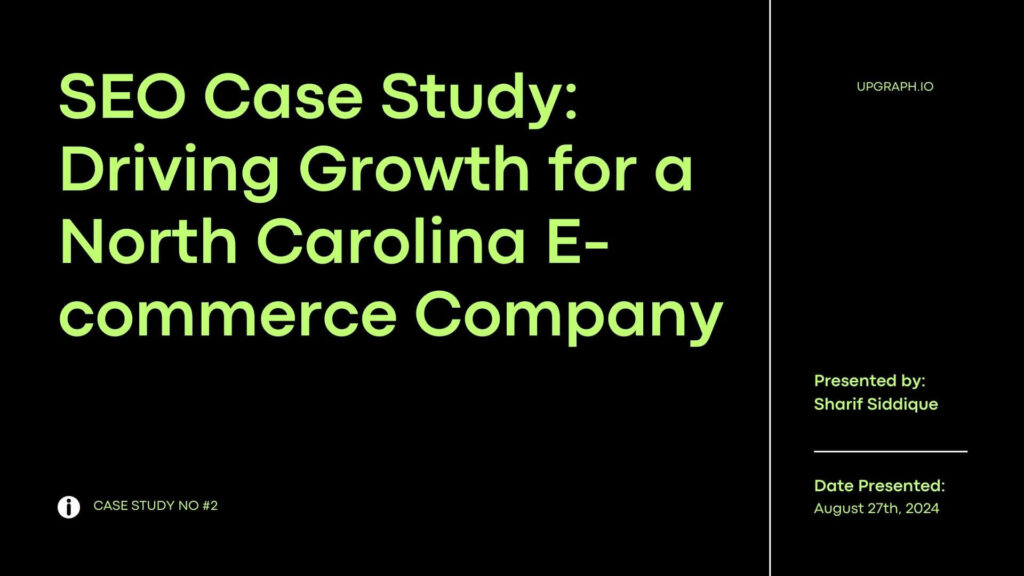At Upgraph, we believe that successful SEO requires more than just implementing strategies—it’s about understanding the unique needs of each client and creating tailored solutions that drive real results.
This case study showcases how we helped a Shopify-based e-commerce company in North Carolina achieve a 30% increase in search traffic and a 40% boost in sales within 6 months. The e-commerce owners came to us, choosing our SEO service to address their growth challenges and enhance their online visibility.
Our founder, Sharif U. Siddique, led this project personally, bringing over a decade of SEO expertise to the table.
His hands-on approach ensured that every aspect of the SEO strategy, from technical fixes to content optimization and link-building, was executed with precision and purpose.
What followed was a transformation that turned the client’s online presence into a powerful growth engine.
Client Background
The client operates in a highly competitive e-commerce niche, selling products that appeal to a specific demographic.
Despite previous SEO work, they struggled to generate significant organic traffic and felt that their existing content wasn’t converting visitors into buyers. Their primary concerns were:
- Lack of consistent organic traffic growth.
- Low conversion rates, even when traffic increased.
- A declining ROI on previous SEO investments.
Given these challenges, the client sought a comprehensive solution that would address both their technical issues and content gaps, driving sustained growth.
SEO Strategy Development
Initial Analysis
We began with a thorough assessment of their site, starting with a technical SEO audit. This revealed 6 critical issues that had been hampering both user experience and search engine rankings:
- Slow Page Load Speed: We found that large, unoptimized images and excessive code were slowing down page load times. Slow websites lead to higher bounce rates and reduced conversions.By optimizing images and minifying CSS and JavaScript files, we significantly reduced page load times, improving both UX and SEO.
- Broken Links: Numerous internal and external broken links were impacting user experience and search engine crawling. We fixed all broken links and implemented a system to regularly check and resolve any future broken links.
- Duplicate Content: The site had several instances of duplicate content, which was diluting SEO efforts. We systematically eliminated redundant pages, consolidated content where necessary, and used canonical tags to point search engines to the correct pages.
- Poor Mobile Optimization: The mobile version of the site wasn’t fully responsive, which was concerning given that over 60% of the site’s traffic came from mobile users. We improved the site’s mobile-friendliness by refining the layout, optimizing for touch interactions, and ensuring that pages loaded quickly on mobile devices.
- Missing Alt Text: Images lacked alt text, which is crucial for SEO and accessibility. We added keyword-rich, descriptive alt texts for all product and blog images, enhancing SEO performance and improving accessibility.
- Incorrect Canonical Tags: Canonical tags were incorrectly implemented, leading to duplicate content issues. We corrected all canonical tags to ensure that search engines recognized the main version of each page.
Content Strategy
Content is crucial in improving search visibility and engaging potential customers. We focused on two core areas: content creation and content optimization.
- Blog Posts: We created and published 39 blog posts centered around the client’s main product offerings. Each post was crafted to target specific long-tail keywords relevant to the client’s niche, and internally linked to product pages to guide traffic to the key sales areas. These posts didn’t just target SEO metrics; they also aimed to educate potential customers, positioning the client as an industry authority.
- Content Optimization: We revisited the client’s existing product pages, optimizing meta descriptions, titles, and on-page content with relevant keywords. We also restructured the internal linking strategy to improve page authority flow and ensure important pages received more link equity.
Link-Building Strategy
To enhance domain authority and drive qualified traffic, we devised a robust link-building strategy focused on high-quality, relevant backlinks.
- High-Authority Backlinks: Over the 6-month period, we secured 65 guest posts on high-authority, niche-relevant websites. Each post included backlinks to key product pages and blog posts, significantly improving the client’s domain authority and bringing in targeted traffic.
Implementation
We broke down the project into three key phases:
- Phase 1: Technical SEO Fixes
The first two months focused on resolving technical issues, ensuring the foundation was solid before we moved on to content creation and link-building. - Phase 2: Content Creation and Optimization
After addressing the technical challenges, we started developing content that resonated with the target audience while optimizing existing pages. This phase also involved regular blog posting, targeting long-tail and highly relevant keywords. - Phase 3: Link-Building Campaign
In the final phase, we focused on building high-quality backlinks to boost the site’s authority. We identified guest blogging opportunities and secured placements that aligned with the client’s niche, ensuring the incoming links were valuable both for SEO and for referral traffic.
Results
The impact of our efforts became evident within a few months, and by the end of the 6-month campaign, the client experienced remarkable growth:
- Search Traffic: Organic search traffic grew by 30%, largely due to improved technical performance and the consistent publication of optimized content.
- Sales Growth: The enhanced user experience, coupled with increased targeted traffic, resulted in a 40% increase in sales.
- Keyword Rankings: Rankings for the client’s primary keywords saw significant improvements, with many terms reaching the first page of Google.
These results not only improved the client’s online visibility but also fostered sustainable growth by attracting more qualified leads and conversions.
Challenges and Solutions
Challenges
Although the results were impressive, the project wasn’t without its challenges:
- Complex Technical Issues: The technical SEO problems were deep-rooted and had been neglected for years, requiring a thorough and methodical approach to resolve.
- Content Gaps: The existing content lacked depth and failed to engage users, so we had to develop a fresh content plan that would attract and convert the right audience.
Solutions
- We tackled the technical issues by prioritizing the most critical problems first. Once these were resolved, we could shift focus to creating content that would engage users and building high-authority backlinks to improve the client’s domain strength.
- Additionally, the collaboration between our SEO team and the client’s content team was crucial for ensuring that our strategies aligned with their brand voice and marketing goals.
Client Feedback
The client was thoroughly impressed with the results. They reported:
“The growth in both traffic and sales has been incredible. What impressed us most was the holistic approach — from fixing technical problems to creating content that truly resonates with our audience. We now have a steady stream of organic traffic and have increased our revenue significantly.”
Conclusion
This case study highlights the power of addressing technical SEO issues, developing a targeted content strategy, and building authoritative backlinks to drive sustained growth for an e-commerce business on Shopify.





